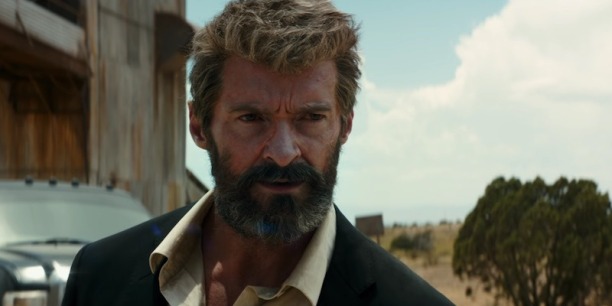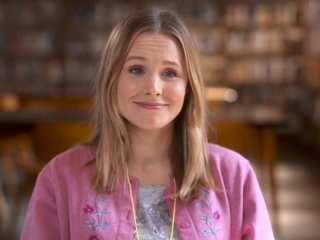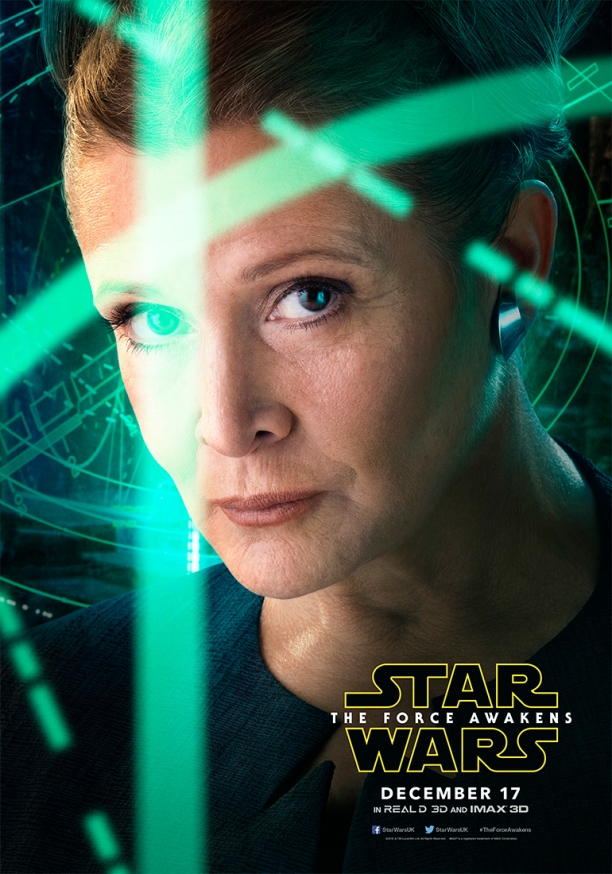
My husband and I went on a rare movie theater date last weekend, because the newest (and last) Wolverine movie was out, and we love us some Wolverine. Logan does not disappoint. Much has been made of its grittier tone and R rating – which, as my husband enjoyed pointing out, makes things far more realistic. When you have adamantium-grafted bone claws that come out of your knuckles when you get angry, along with crazy strength, you’re probably going to end up killing someone at some point. So, this Wolverine movie is more appropriately gory. We’re talking decapitations, fountains of blood, the works.
But, along with the gore, there are a lot more feelings in this Wolverine outing, versus previous movies. The anguish of Logan’s life is closer to the surface. Instead of brooding quietly, this Wolverine is more clearly about to break. To pay the bills, he works as a chauffeur while hiding out over the border in Mexico and caring for a senile Charles Xavier. The year is 2029. Logan is, himself, an old man. Hugh Jackman makes it clear from the first frame that Wolverine is tired. Something – presumably the adamantium fused to his skeleton – is slowly poisoning him. He’s had enough bullsh*t from young punks, like the thugs who try to steal the tires off his limo. His patience is shot, and anyone who tries to damage his livelihood will see his adamantium-bound claws up close.
Enter the girl who bring backs his will to fight. A Latina woman, a former nurse at a medical research facility that is purportedly doing a childhood cancer study, but is in fact working on something far more sinister, dogs Wolverine and begs him to help her. He is the only one who can. He won’t hear her out, until she waves money in his face – enough to buy the Sunseeker he’s promised Charles, so they can live out their remaining days at sea. There is a girl, Laura. She is like you, she tells him, and Wolverine doesn’t really believe her, but money talks, and Laura needs to go to Canada, where she’ll be safe from the bad guys who want to kill her. They make arrangements. He comes to pick up her up, but the bad guys shove a wrench in their plans, as bad guys do, and Wolverine sees sweet little Laura backed into a corner and forced to fight. Laura is exactly as advertised.
At its heart, Logan is a Western road movie, with mutants. This is no great secret or revelation; the filmmakers obviously had fun playing with common Western tropes. At one point, the characters watch the movie Shane, which makes it almost too clear where the movie is going. During the *road* part of the road movie, the characters encounter a horse trailer that has been run off the interstate, leading the to the escape of the horses. Charles urges Logan to stop and help. “Someone will come along,” Logan assures him. “Someone has,” Charles reiterates. So, they help, and, as happens in most Western movies, the indebted family – innocent, hard-working types – invite the road-weary trio to their home for a bite of dinner and a rest.
It thrilled me more than a little bit that these innocent, hard-working types were a wholesome, African American family by the name of Munson: a handsome father, a lovely, intelligent mother (who seems to have a much better read on the travelers than her trusting husband), and a disciplined, if slightly rebellious, teenage son. Black cowboys were absolutely a thing in the Old West, but we don’t expect to see them in a movie that takes place in 2029, so kudos for the subversion of stereotypes. Anyway, Logan is quick to turn down their offer, but Charles insists that they accept.
*SPOILER ALERT* I’m going to talk about what happens next in the movie, and the end, and everything else, so if you haven’t seen it yet, seriously, stop reading.
*I’m not kidding*
*Okay, you were warned*
I was a little upset with Charles at this point. Clearly, he knows by now, having been in all the X-Men movies in one timeline or another, played by one actor (or computer graphic) or another, that innocent bystanders who help Wolverine are rarely safe. He has already seen the types of people who are after Laura. But it has been years since Charles slept in a real house with a real family, and his yearning for that feeling overrules his better judgment. So, in the end, they accept the invitation. I felt even more nervous for the survival of this beautiful family, given their race. And, if you’ve seen the movie, you know
*Seriously, people, last warning*
I was right to be nervous. Charles wakes up in a bed, in a house, to Logan’s form standing over him and explains that this feeling – of being in a family – this is why he insisted they spend the night with the Munson family. The form lays a hand on Charles’ shoulder – and then the claws come out and slice through ailing Professor X. Here’s an interesting surprise (but only if you haven’t followed Logan’s story in the comic books). Laura, known as X-23 in the lab, is not the only mutant created using Logan’s DNA. There is also X-24, a younger, ragy-er clone of Logan.
Even in the everybody-comes-back-to-life world of comic books (and Professor X has, in both the comics and the movies), already-frail 90-year-olds in the middle of a cornfield with zero medical supplies do not come back from adamantium claws through the chest. We know Professor X is doomed the minute we hear that *snikt* ring through the attic. Naturally, Wolverine battles his younger, meaner (“soulless,” as described by the rep from the medical research company, I believe) self – and this part of the epic battle, I can get behind. Logan is battling his own rage, his own bad intentions, his own past misdeeds, in favor of defending Laura, his (lab-created) offspring – a more innocent version of himself. This is his shot at redemption. Comic book characters battling their own evil twins has been done to death, but Wolverine has such a rich blend of violence and redemption in his past – mixed with the promise of living on through Laura, if he can save her from the evil version of himself – that rarely has it been more fitting.
However fitting the Wolverine-on-Wolverine action is, I am wrecked with the rest of the farmhouse battle. Why does the Munson family have to die? One review (warning, obviously: spoilers) I read said that this part felt “manufactured.” I think that’s the best way to put it. Wouldn’t it have been sufficient to leave the Munsons bloodied and beaten, and pissed that these strangers led the devil to their doorstep? I would have been delighted if the film had proven me wrong, but I knew as soon as Charles talked Logan in to going to their house, that this family was as good as dead. X-24 and the Reavers make their way through the Munson family like a hot knife through butter, and for what? They’re just more innocent bystanders who die because they were being nice.
Charles Xavier, reduced to a shell of his former self and dying, helplessly, in bed, seems more fitting for this movie. He remembers, just before X-24 slices and dices him, what happened to make Logan smuggle him over the border to live in a junkyard. Charles has been suffering from seizures, and with a brain like his, a seizure is practically a miniature Hiroshima. Dozens of lives were lost in a mysterious incident in Westchester – which is the canonical location of Xavier’s School for Gifted Youngsters. This may explain why we don’t see Storm, Rogue, Cyclops, Beast, or any of the other original X-Men (though the newer X-Men movies have retconned the timeline so much that I can’t keep track of who’s supposed to have been around anyway). Charles knows he didn’t deserve to have one more night of peace, or a comfortable bed, and he remembers why Logan’s rage is so close to the surface these days. And then he dies, thinking that Logan has killed him because he could not forgive him. Oh, the feels. This scene was so overwhelming with emotion that I have to say the filmmakers did excellent work. Charles Xavier was such a powerful man in his prime, but having him die, and ultimately cause the death of some innocent bystanders because he was too selfish to put their safety above his comfort – this shows that old age and infirmity have mostly reduced him to being a regular old human, instead of practically a god. In Westerns, the heroes are always flawed, so I suppose Charles had to be taken down a few pegs to fit the archetype.
With the Munsons and Xavier dead, all that’s left is for Logan to take Laura to the pre-arranged meeting place. The other children from the medical research facility are meeting up in North Dakota, where they will cross the border into Canada to a place called Eden, where the other remaining mutants are supposedly gathering. The coordinates for their meeting appeared in an X-Men comic – oh, yes, they have X-Men comics in the X-Men universe, which is a nice little bit of metatextuality – which leads Logan to doubt their reliability. Still, though, he drives. And when he becomes too weak, from his preexisting condition and his injuries from X-24, Laura takes over. Wonder of wonders, the other children have made it. They treat Logan’s injuries and give him a serum developed at the facility to help him heal faster and be stronger. While he is sleeping, they trim his beard and hair so he looks like he does in the comic books (and earlier X-Men movies). They ask him to come with them to Eden, but he refuses. This is a Western; the hero always rides off into the sunset (or dies) at the end, because he is too impure from the necessary violence he used to rescue the townsfolk.
Naturally, the Reavers have picked up the trail and are on the way to intercept the children before they cross the border, and Wolverine, realizing this, downs the remaining serum and takes off after the bad guys. What a gift this is, in the last Wolverine movie: Wolverine, for a minute or two, is (to borrow from the MCU) hulked out and unstoppable – and even his haircut harkens to his glory days. Gone, for a moment, is the weight of all the harm he has caused in his life. For now, he is simply unleashed to fight for the lives of innocents. We are treated to another tag-team fight with X-23 (Laura), which also deserves a mention. In the beginning of the movie, about half a second after Logan learns that her Mexican nurse and Charles are both right – Laura really is just like him – Logan is forced to fight off the Reavers with her. No (or virtually no) words are exchanged between them – they work together seamlessly. She launches herself off his back at the bad guys. She throws him a pipe to take someone out. He knows she can take care of herself, so he’s fine with driving off with Laura clinging to the top of his limo. There’s more of that in the final fight, only now, briefly, Logan is fully Wolverine again. It’s great fun.
And then, just like that, it’s over. The serum wears off, and X-24 has dealt Logan a critical blow that we know he won’t be coming back from. Laura finishes X-24 off with the adamantium bullet Logan was saving to kill himself with – the symbolism here is so plain it’s almost painful. Logan and Laura share a final moment that promises to squeeze any remaining tears out your eyes (which is just happened to me, simply from remembering it). The children hold a funeral for him before continuing to Canada, and, we hope, safety. I have to say, the political timeliness of this journey is overwhelming. The children’s very existence is illegal – as messed up as the world is in 2029, creating human clones with mutant powers is still very much illegal. And so, these literally illegal children journey from their birthplace in MEXICO, into the United States, where they face endless persecution and constant threat of death. Therefore, they continue on their way to Canada, where actual freedom beckons. For the United States, for them anyway, is no longer the land of the free. That mantle now belongs to Canada – as we are now seeing in the real world, where illegal immigrants now cross from the US into Canada to escape imprisonment and deportation. The X-Men have always been an allegory for marginalized groups, and that is no less true in Logan.
Part of me really wanted to see some adamantium claws punching up through the ground where the kids laid Logan to rest in a post-credits scene, but this is not that kind of X-Men movie, for all its parallels to X-Men (2000). (Logan finds young female mutant in need of help, reluctantly assists her in reaching safety, then ups the hero ante in the third act, mortality be damned – the story arc is virtually identical). The campiness and middle-claw jokes belong in a younger mutant’s story. Hopefully, we will see those again with a movie featuring Laura. But, for now, Wolverine as we know him can rest in peace.



Recent Comments